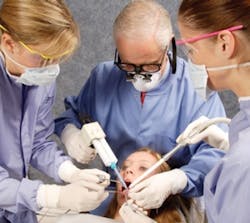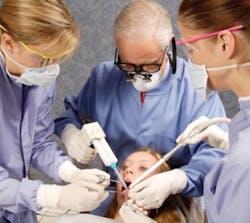Fixing the practice that has gone off course
For more on this topic, go to www.dentaleconomics.com and search using the following key words: long-term goals, Rambo hygiene, practice on course, Dr. Steve Rasner.
The U.S. Department of Statistics reported that the recession officially started December 2007. Since then, $8.3 trillion in assets have been lost. I am sure we all know stories of colleagues who have had to "unretire."
Most of us are somberly aware of the 20% to 35% decline in our industry. The bottom line – fewer new patient calls, more responses such as, "I’ll have to think about it," less cash flow, and more stress.
Listen, I am one of you. I know that even in a great practice, complacency can creep in and affect care. It’s easy to overlook a perio patient who once was on a successful three-month recall that has morphed into once every six months.
I know how a patient you once restored can slip four years without an FMX. When our practice is struggling, I always pontificate to the staff, "Let’s start by being great clinicians."
No one is advocating taking unnecessary radiographs or cramming unneeded work down our patients’ throats. Part of being a great clinician is taking the time to evaluate our patients’ true state of health and educating patients about the relevant treatment options.
If this results in greater productivity in a slumping office, then it is a true win-win for the patient and your office. Begin your road to recovery with three sets of goals in mind:
Short-term goals
►Restart the morning meeting
I know it has fizzled. No one wants to meet when they are getting beat up every day. I get it. Pay the staff to get there 30 minutes before the meeting.
The task is to review the charts:
- Who is due for an FMX ?
- What treatment plans were previously discussed but not accepted?
- How accurate and up-to-date are patients’ soft tissue management?
What about the added cost for this extra half-hour at a time when you are struggling? If everyone does diligence to the extra research time, it will become one of your better investments. There is no way you won’t experience a serious positive impact on your productivity and collections.
►The Rambo hygiene recall purge
Most offices have lost touch with the power of a maximized hygiene schedule. Filled hygiene schedules are profitable, spin off work, and serve as a great source of internal marketing. Be honest. Does your recall program amount to someone remembering that someone’s overdue?
Here’s the fix: Every team member has a six-per-week recall quota. That means assistants, front desk, and hygiene. Like staff, we are all fighting for "what we used to have." Find six patients during regular hours or kick in 30 extra minutes. Nothing bad can come from this. If you have three staff members and are 50% successful, that will be nine recalled patients per week. That’s a full hygiene day! And remember, no whining.
Mid-term goals
►Bringing the significant other to the initial visit
I know what you are thinking. You can barely get the new patient to come in and now I am advocating the new patient bring along his or her significant other! That does not happen now because you don’t ask for it to happen. You will not get 100%, but you can expect between 50% and 80% success depending on the verbal skills of your patient coordinator.
Consider this – it’s not 1980 anymore. Incorporating implants, perio plastic surgery, and a comprehensive treatment planning approach invariably leads to higher out-of-pocket cost to patients. You may have the greatest staff, facility, and people skills on the planet, but no one is committing to a $20,000 treatment plan without the input of a significant other.
► Putting out the fires treatment plans
Although statistics suggest things are turning around, I see patients daily that continue to struggle with the economy. Not doing so many full-mouth rehabs these days. One approach to patients who have put their oral health on the back burner would be to start by "putting out the fires."
Maybe this involves quadrant-scaling, endo therapy, or even removable temporary tooth replacement. This treatment approach would not include fixed prostho or implant therapy. It would likely be under $5,000.
Many of your patients want to do something but cannot commit to $20,000+ for full rehabs. For many of these patients, some care now is a better alternative than saving for the ideal treatment plan.
► Same day treatment plans
Thanks to the comprehensive CE now available, I have been fortunate to train with the leaders in our field. I’ve learned the value of mounted pre-op models, diagnostic wax-ups, and the recording of finite information relevant to the pre-op condition of a patient’s soft tissue. We often need to refer our patients for pretreatment evaluation for perio, endo, and other disciplines.
Naturally, this involves a time commitment from the patient. Guess what else it does? It decreases the chances of treatment acceptance. When you can offer patients a clear and irrefutable treatment plan on day one, then you should.
Let’s say you have a patient with great perio, an intact dentition, and maybe some minor restorations to treat. The patient’s chief complaint is a first premolar, broken to the gingival margin, with a history of endo. That’s an extraction and implant with minor restorative. That is a day one treatment plan.
Clearly there are times when we need the aforementioned information, but there exists a bevy of day one opportunities, and day one always increases the probability of "yes."
Long-term goals
► Expanding your armamentarium
Anyone invested in implant education may notice an interesting trend. Your colleagues now include endodontists and prothodontists, as well as the rest of us. And I am referencing the surgical courses!
Continuing education has evolved from the one-day course of the ’80s to detailed continuums in which clinicians can become proficient at an array of disciplines previously reserved for postgrad specialties. Every practitioner has to have the integrity to assess his or her true capabilities.
The author is not recommending a weekend implant or perio course followed by a plunge into treatment. There are a multitude of treatments that should be in the hands of specialists who have the most skill and experience.
That being said, the author notes that there are many thriving dental practices that have incorporated perio, endo, and implant dentistry at very sophisticated levels of care.
Long-term success in 2010 requires more than the basics taught in dental school. There isn’t a doctor reading this who can’t skillfully expand his or her range of services, and age is no excuse.
► Eliminating the "poor me" attitude
No one is stating that what we do is easy. It’s not all that difficult to slip into a pity party. "Why can’t I keep staff members?" "The major factory in town just closed." "Another dentist just moved into town."
Here is the problem: Feeling bad for ourselves does not change anything, and if it lasts six months to a year, you still have the same problem. The sooner you realize no one is going to fix this better than you, and the sooner you do, you won’t need to read an article like this!
Remember, you have the most to gain or lose from the business you built. Stop waiting for someone or something to rescue you. Stop waiting for the kids to leave home or the absence of risk. Take a good look in the mirror and realize, that’s the person who needs to fix this thing.
Dr. Stever Rasner is a general practitioner from Bridgeton, N.J. In 1998, he founded Realizing the Dream, a collection of professional practice tools that include speaker services, books, in-office training tapes, videos, and practice management products. He can be reached at (800) 337-8435 or [email protected].
Past DE Issues

